
The Temple Mount, also known as Haram al-Sharif, al-Aqsa Mosque compound, or simply al-Aqsa, and sometimes as Jerusalem's holyesplanade, is a hill in the Old City of Jerusalem that has been venerated as a holy site for thousands of years, including in Judaism, Christianity and Islam.

The Gates of Cairo were gates at portals in the city walls of medieval Islamic Cairo, within the present day city of Cairo, Egypt.

The Azeemi Sufi Order, known in Urdu as Silsila Azeemiyya , known in Arabic as Al-Ṭarīqah al-Aẓeemiyyah

Silsila is an Arabic word meaning chain, link, connection often used in various senses of lineage. In particular, it may be translated as "spiritual genealogy" where one Sufi Master transfers his khilafat to his khalîfa, or spiritual descendant. In Urdu, silsila means saga.

The Temple Mount, a holy site in the Old City of Jerusalem, also known as the al-Ḥaram al-Sharīf or Al-Aqsa, contains twelve gates. One of the gates, Bab as-Sarai, is currently closed to the public but was open under Ottoman rule. There are also six other sealed gates. This does not include the Gates of the Old City of Jerusalem which circumscribe the external walls except on the east side.

Dome of the Chain is an Islamic free-standing domed building located adjacently east of the Dome of the Rock in the al-Aqsa Mosque compound in the Old City of Jerusalem. It is one of many small buildings that can be found scattered around the Al Aqsa Mosque. Its exact historical use and significance are under scholarly debate. Erected in 691–92 CE, the Dome of the Chain is one of the oldest surviving structures at the al-Aqsa Mosque compound.
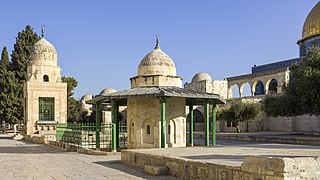
The Fountain of Qasim Pasha is an ablution and drinking fountain in the western esplanade of the al-Aqsa Compound in the Old City of Jerusalem. It is in front of the Chain Gate.
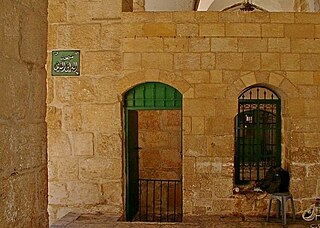
The al-Buraq Mosque is a subterranean musalla next to the Western Wall, near the southwest corner of the Masjid al-Aqsa compound in the Old City of Jerusalem. This mosque is called al-Buraq Mosque because of a ring that is nailed to its wall where Muslims believe Muhammad tied the Buraq that carried him from the al-Haram Mosque to the al-Aqsa Mosque during the Night Journey.
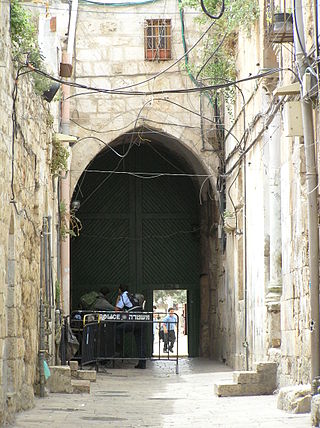
Bāb Ḥuṭṭa is a neighborhood in the Muslim Quarter of the Old City of Jerusalem to the north of Al-Aqsa Compound. The name literally means "Forgiveness Gate", referring to the Remission Gate of the Haram compound, connected by Bāb Ḥuṭṭa Street.

The Dung Gate, also known in Arabic as the Silwan Gate and Mughrabi Gate, is one of the Gates of the Old City of Jerusalem. It was built as a small postern gate in the 16th century by the Ottomans, first widened for vehicular traffic in 1952 by the Jordanians, and again in 1985 by the Israeli authorities. The Dung Gate is a main passage for vehicles coming out of the Old City and for buses headed to the Western Wall.

The Al-Aqsa mosque compound in the Old City of Jerusalem has four minarets in total: three on the western flank and one on the northern flank.

The Inspector's Gate is one of the gates of the al-Aqsa Compound. It is the second-northernmost gates in the compound's west wall, after the Bani Ghanim Gate. It is north of the Iron Gate.

The Cotton Merchants' Gate is one of the gates of the al-Aqsa Compound. It is by the western esplanade of the compound and leads to the Cotton Merchants' Market, a sūq, it is also called the Gate of the Cotton Merchants' Market. Its intricate eastern façade makes it one of the most recognizable and "the grandest of the Haram gates".
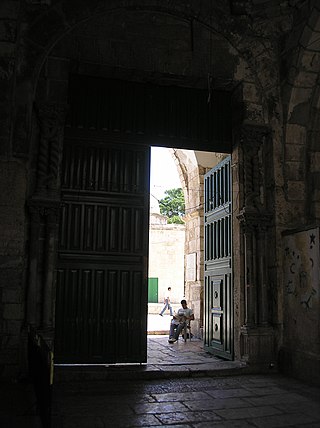
The Gate of the Chain or Chain Gate is one of the gates to the Al-Aqsa Mosque compound on the Temple Mount in the Old City of Jerusalem. It was known early Islamic period Bāb Daud, which means David's Gate. It was also known as Bāb al-Maḥkama, Gate of the Law Court, named after the nearby Maḥkama in the Tankiziyya building.

The Dome of Yusuf Agha is a small square building with a dome in the al-Aqsa Compound, in the courtyard between the Islamic Museum and al-Aqsa Mosque (al-Qibli).

The ʿUthmāniyya Madrasa is a historic school in Jerusalem. It is by the western esplanade of the al-Aqsa Compound. It was established in 1436, then became an Ottoman imperial provincial madrasa.
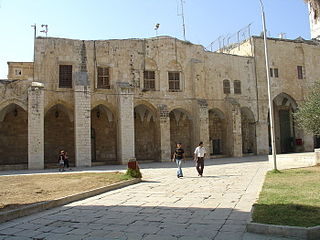
The at-Tankiziyya is a historic building in Jerusalem that included a madrasa. It is part of the west wall of the al-Aqsa Compound. It is also known as the Maḥkama building.
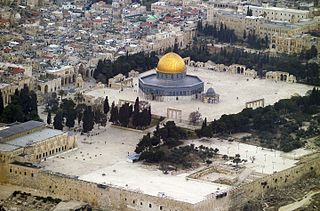
Al-Aqsa or al-Masjid al-Aqṣā is the compound of Islamic religious buildings that sit atop the Temple Mount, also known as the Haram al-Sharif, in the Old City of Jerusalem, including the Dome of the Rock, many mosques and prayer halls, madrasas, zawiyas, khalwas and other domes and religious structures, as well as the four encircling minarets. It is considered the third holiest site in Islam. The compound's main congregational mosque or prayer hall is variously known as Al-Aqsa Mosque, Qibli Mosque or al-Jāmiʿ al-Aqṣā, while in some sources it is also known as al-Masjid al-Aqṣā; the wider compound is sometimes known as Al-Aqsa mosque compound in order to avoid confusion.
The Al-Aqsa Mosque building, also known as the Qibli Mosque/Chapel, is the congregational prayer hall at the southern end of the greater Al-Aqsa compound.

















